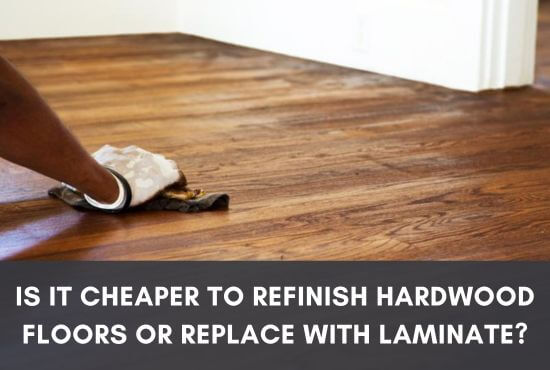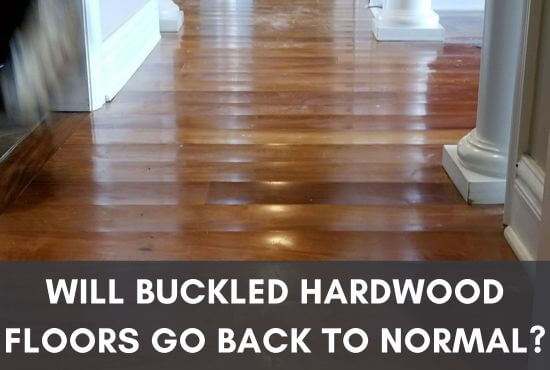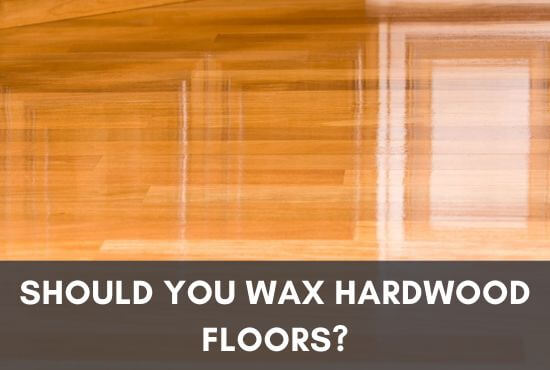Mold is like an unwanted guest that can sneak into your home, hiding under your hardwood floors.
The common signs of mold under hardwood floors include creaky floorboards, a musty smell, water stains and damage, warping or buckling of the boards, color changes on the floor, and health issues like allergies or breathing problems that are linked to mold exposure.

It’s not just about the ugly patches; mold can also be harmful to your health. Certain molds, particularly black mold, release harmful substances called mycotoxins into the air as they grow (1).
Additionally, the tiny particles they spread can trigger or worsen asthma and allergy symptoms, making your home less comfortable.
It’s important to catch and deal with it early. In this blog, I’m going to let you know the signs of mold under hardwood floors, how it gets there, and what you can do to get rid of it.
Table of Contents
- 1 Signs Of Mold Under Hardwood Floors
- 2 Can Mold Grow Under Hardwood Floors?
- 3 What Causes Mold On Hardwood Floors?
- 4 Is Mold On Hardwood Floors Dangerous?
- 5 How To Get Rid Of Mold Under Flooring?
- 6 Conclusion
- 7 FAQs
- 7.1 Q. What kills mold on hardwood floor?
- 7.2 Q. What does mold on hardwood floor look like?
- 7.3 Q. What do moldy floors look like?
- 7.4 Q. Can I leave vinegar on mold overnight?
- 7.5 Q. What is the best home made mold killer?
- 7.6 Q. Does vinegar stop mould growth?
- 7.7 Q. How do I permanently get rid of mold in my house?
Signs Of Mold Under Hardwood Floors

If you suspect there might be mold under your hardwood, concrete, or laminate flooring, here are some signs to look out for:
Creaky Floorboards

When mold finds its way under hardwood flooring, it can cause the material to lift or shift, resulting in creaky floorboards.
As you walk across the room, you might notice more creaking sounds due to the loosened flooring. Mold tends to break down the wood, causing it to lose its solid, firm nature and thus creating a noisy nuisance whenever pressure is applied.
Buckling or Warping

Mold retains moisture, and when it grows under hardwood floors, this moisture can cause the wood to buckle or warp. The warping can create an uneven surface, making your floor look distorted.
Buckling is a visible cupping or crowning effect on the boards, which not only looks unappealing but also poses a trip hazard.
This is a clear sign that there’s unwanted moisture, possibly from mold, affecting your hardwood floor.
Musty Odors
In many cases, mold is first detected by its distinct musty smell.
If a room or certain area of your home has a lingering musty smell that doesn’t go away with regular cleaning or airing out, it’s a strong indicator that mold might be hiding under the flooring.
The odor comes from the mold’s metabolic processes as it grows and spreads.
Here’s how you can get rid of musty odors from hardwood floors.
Water Damage

Signs of water damage like dark spots or patches on the flooring often hint at mold growth.
Mold thrives in moist conditions; hence, any water damage could provide a conducive environment for its growth.
If you’ve recently had a water leak or flooding, it’s wise to check for other signs of mold as well to ensure it hasn’t taken up residence under your floor.
Discoloration
You may also notice dark spots, stains, or areas where the color of the wood has changed due to mold under floors.
These discolorations are often a result of the mold feeding on the wood or the moisture causing the wood to darken.
Water Stains
Water stains on hardwood floors could be an indicator of excess moisture, which is a breeding ground for mold. Water stains can appear as dark patches or rings.
They might be a result of spills, leaks, or high humidity. It’s important to address the source of moisture to prevent mold growth.
Health Symptoms
Mold exposure can lead to a variety of health symptoms, especially for individuals who are sensitive or allergic to it.
Common symptoms include sneezing, runny or stuffy nose, coughing, itchy eyes, throat, or skin, and worsened asthma symptoms.
If you or your family members experience these symptoms more frequently at home, it might be due to mold under your hardwood floors.
Can Mold Grow Under Hardwood Floors?
Indeed, mold can find its way under hardwood floors. It thrives in dark, moist areas, so if water manages to seep through, the space under your flooring becomes an ideal spot for mold to grow.
Mold tends to grow on organic materials, especially in places with high humidity or where moisture is trapped.
This puts your hardwood floors at risk, particularly in the aftermath of water or flood damage, as the underlay can harbor mold, leading to damages of bouncy or sagging floors and potential health risks over time.
What Causes Mold On Hardwood Floors?
Mold on hardwood floors primarily arises from excessive moisture. This excess moisture can be due to a variety of factors such as spills, leaks, or high humidity.
For instance, if a liquid is spilled on the floor and not cleaned up promptly, it can seep into the cracks and crevices of the hardwood, creating a damp environment favorable for mold growth.

Similarly, leaks from plumbing or appliances can introduce unwanted moisture to the flooring.
Additionally, living in areas with high humidity levels can also contribute to the problem, as the moisture from the air can settle on, and gradually seep into the wood.
These conditions can invite mold, making it a persistent issue that can damage the aesthetics and integrity of your hardwood floors over time.
Black Mold Under Flooring
Black mold, known scientifically as Stachybotrys chartarum, is a type of mold that has the ability to hide under your flooring, growing silently and potentially causing a myriad of problems both for your home and your health.
This type of mold releases mycotoxins, which are toxic substances that can lead to health issues such as respiratory problems, skin irritation, and fatigue among others.
Moreover, the growth of black mold can compromise the structural integrity of your flooring.
The longer it goes unnoticed, the more damage it can cause, leading to costly repairs or replacements in the future.
It’s imperative to address black mold at the earliest sign to mitigate its harmful effects and maintain a healthy living environment.
Is Mold On Hardwood Floors Dangerous?
Mold on hardwood floors can be bad for both your health and your home. It can cause health issues, especially for people who have allergies or asthma.
Besides making you sick, mold on hardwood can also damage your beautiful house flooring to a point where they can’t be fixed.
Once mold sets in, it can be harmful to the wood, making the flooring weak. Mold can grow and spread quietly, but the problems it causes can be loud and long-lasting.
How To Get Rid Of Mold Under Flooring?

Discovering mold on your flooring can be alarming as it’s not only a threat to your home’s aesthetics but also to your health, especially for individuals with allergies or asthma.
Addressing minor mold issues promptly can prevent them from escalating into serious problems.
I’m going to share a step-by-step approach to tackling minor mold problems on your flooring, ensuring a safer and cleaner living environment.
Materials Needed
- Gloves, goggles, and a N-95 mask
- Towels or dehumidifiers
- Vacuum with a HEPA filter
- Scraper (for peeling off vinyl or linoleum if necessary)
- Hot water and soap
- Mold and mildew cleaner or a bleach solution (1 cup of bleach mixed in 1 gallon of water)
Step 1: Preparation
Ensure your floor is completely dry by removing any excess water or moisture using towels or dehumidifiers.
I opted for the SIMSEN 95oz dehumidifier for this task due to its high-efficiency dehumidification capability, perfect for covering up to 720 sq ft.
The quiet operation in sleep mode ensured a noise-free environment while it diligently worked to lower the room’s humidity, making it noticeably drier and ready for the mold removal process.
If there’s standing water in your crawl space, it can also cause moisture under hardwood floors that can lead to severe damages. You can install a dehumidifier in crawl space to remove water under your floors area.
Step 2: Initial Cleaning
Utilize a vacuum with a HEPA filter to get rid of loose mold spores and debris from the affected area.
I picked the Shark NV360 Lift-Away Vacuum for this task due to its powerful suction and Anti-Allergen Complete Seal Technology with a HEPA filter, ensuring that dust and allergens were trapped inside the vacuum.

The swivel steering feature enabled easy maneuvering around the affected area, making the initial cleaning process efficient and effective in prepping the area for the subsequent mold removal steps.
Step 3: Clear the Area
Remove any clutter, furniture, rugs, or items that were in contact with the mold from the surrounding area.
If necessary, carefully remove carpeting, pry off wall trimming and flooring to expose the moldy area.
For this task, I would recommend the Plastic Razor Blades scraper tool, which proved to be an excellent choice due to its sharp yet safe plastic blades that effectively removed stubborn residues without causing any scratches.
The ergonomic handle provided a comfortable grip, making the scraping process much easier and efficient, ensuring a well-prepped area for the subsequent mold removal steps.
Step 4: Ventilation
Open windows for ventilation to allow fresh air in and mold spores out.
If available, use a fan to direct the moldy air towards the window.
Step 5: Scrubbing

Create a cleaning mixture with hot water and soap. Gently scrub the affected area with the cleaning mixture to loosen and remove the mold.
Step 6: Disinfection
Apply a suitable mold and mildew cleaner or a diluted bleach solution (1 cup of bleach in 1 gallon of water) on the moldy floor.
You can also go for RMR-86 instant mold stain and mildew stain remover spray for this task, as it worked wonders for me on the stubborn mold stains.
The fast-acting formula started working instantly, targeting the deeply embedded stains without the need for any scrubbing.
It was safe to use on my hardwood floor and effectively removed the mold stains, making this cleaner a valuable asset in achieving a mold-free living space.
Let the cleaning solution sit for about 10 to 15 minutes to disinfect the area.
If you want to clean your floors thoroughly, you should disinfect your floor naturally.
Step 7: Rinsing and Drying
Rinse the area thoroughly with clean water. Dry the area completely using towels or dehumidifiers to prevent moisture accumulation that could lead to future mold growth.
Step 8: Assessment and Replacement
Assess the area to ensure all mold has been removed.
Depending on the extent of mold penetration, you might need to install new flooring.
This guide is for addressing minor mold issues. For severe mold infestations or if you are uncertain about handling mold, it’s strongly advised to get professional help to resolve the problem safely and efficiently.
Conclusion
Understanding the signs of mold under hardwood floors and tackling it head-on can save and keep your home healthy.
Don’t let mold turn your cozy haven into a nightmare. Following these steps should help you tackle small areas of mold effectively.
However, if the mold issue persists or has spread extensively beneath the surface, it’s wise to seek professional assistance for a thorough mold removal and to ensure a mold-free living space.
FAQs
Q. What kills mold on hardwood floor?
Mix equal amounts of vinegar and warm water in a spray bottle and spray this mixture on the mold.
Allow the mixture to dry for an hour, then clean the surface with a damp cloth, followed by wiping it with a dry towel.
Q. What does mold on hardwood floor look like?
Deformation, discoloration, and buckling of floorboards are significant signs pointing to a mold issue.
Mold usually manifests as discoloration, staining, or a fuzzy colored layer on wooden floorboards. Typically, a mold infestation occurs after a flooding event in the home.
Q. What do moldy floors look like?
Mold can cause various types of damage to floors. The floor may appear dirty, dusty, fuzzy, or powdery due to mold growth.
If you clean the floor by sweeping or mopping and notice the same texture reappearing within a few days, it’s likely that you have a mold issue.
Q. Can I leave vinegar on mold overnight?
It’s safe to leave vinegar on mold overnight. Being acidic, vinegar can effectively kill 82% of mold spores (source).
However, ensure the area is well-ventilated to prevent any respiratory irritation that the vinegar fumes might cause.
Q. What is the best home made mold killer?
Combine one teaspoon of baking soda with two cups of water and shake well in a spray bottle.
Once fully mixed, spray the solution onto the mold and scrub the area with a brush. Repeat the process if needed. After cleaning, use a damp, clean cloth to wipe off the solution from the area.
Q. Does vinegar stop mould growth?
Vinegar is a versatile household item known for its natural acidic properties. It’s eco-friendly and non-toxic, making it a safe choice for many cleaning applications.
It has the ability to eliminate up to 82% of mold species, including black mold, on both porous and non-porous surfaces like glass, tiles, and other smooth surfaces.
Q. How do I permanently get rid of mold in my house?
The main way to get rid of mold for good is by keeping your home dry. You can do this by letting fresh air in to reduce moisture, which is what mold needs to grow.
John Henry is a passionate co-creator of FlooringFlow.com. a website dedicated to answer all of your flooring related questions. After taking the challenges of flooring DIYs while learning skills for years, John is now ready to share his knowledge related to floor remodeling and projects with you.




![70 Bedroom Color Schemes: [year] Home Bedroom Refresh 70 Bedroom Color Schemes: [year] Home Bedroom Refresh](https://flooringflow.com/wp-content/uploads/2024/07/25-Cool-4th-of-July-Decorations-for-Outdoor-Patio-to-Celebrate-in-Style-16.jpg)


